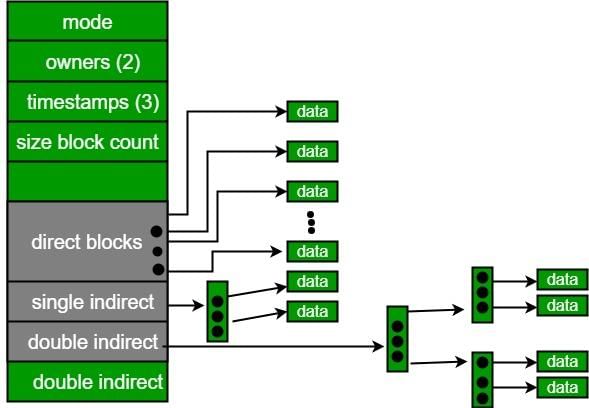Computer Science Engineering (CSE) Exam > Computer Science Engineering (CSE) Questions > The data blocks of a very large file in the U...
Start Learning for Free
The data blocks of a very large file in the Unix file system are allocated using
- a)contiguous allocation
- b)linked allocation
- c)indexed allocation
- d)an extension of indexed allocation
Correct answer is option 'D'. Can you explain this answer?
Verified Answer
The data blocks of a very large file in the Unix file system are alloc...
The Unix file system uses an extension of indexed allocation. It uses direct blocks, single indirect blocks, double indirect blocks and triple indirect blocks. Following diagram shows implementation of Unix file system.

Most Upvoted Answer
The data blocks of a very large file in the Unix file system are alloc...
Introduction:
The Unix file system is a widely used file system in Unix-like operating systems. It manages the allocation of data blocks for storing file data efficiently. When dealing with very large files, it becomes crucial to optimize the allocation strategy to minimize fragmentation and improve performance. In the Unix file system, the data blocks of a very large file are allocated using an extension of indexed allocation.
Indexed Allocation:
Indexed allocation is a file allocation method where a separate index block is used to store pointers to the data blocks of a file. Each index block contains a fixed number of pointers, and each pointer points to a data block. This technique allows quick access to any data block in the file by following the pointers in the index blocks.
Limitations of Indexed Allocation:
While indexed allocation is efficient for small to moderate-sized files, it may not be suitable for very large files due to the following limitations:
1. Memory Overhead: In indexed allocation, an index block is required for every fixed number of data blocks. For very large files, this can lead to a significant amount of memory overhead, as a large number of index blocks need to be allocated.
2. Sequential Access: Since indexed allocation relies on following pointers to access data blocks, it is not efficient for sequential access of large files. The overhead of traversing the index blocks and following the pointers can degrade performance.
3. Fragmentation: Indexed allocation can also suffer from internal fragmentation. If a file does not occupy a complete data block, the remaining space in the block is wasted.
Extension of Indexed Allocation:
To overcome the limitations of indexed allocation for very large files, an extension of indexed allocation is used. In this approach, multiple levels of index blocks are used to create a hierarchical structure.
1. First-Level Index Blocks: The first-level index blocks point to second-level index blocks.
2. Second-Level Index Blocks: The second-level index blocks point to third-level index blocks.
3. Third-Level Index Blocks: The third-level index blocks finally point to the data blocks of the file.
By using multiple levels of index blocks, it becomes possible to allocate and manage the data blocks of very large files efficiently. This hierarchical structure allows for better organization of the index blocks and reduces memory overhead. It also enables faster access to data blocks by reducing the number of levels that need to be traversed.
Therefore, the data blocks of a very large file in the Unix file system are allocated using an extension of indexed allocation to optimize performance and minimize fragmentation.
The Unix file system is a widely used file system in Unix-like operating systems. It manages the allocation of data blocks for storing file data efficiently. When dealing with very large files, it becomes crucial to optimize the allocation strategy to minimize fragmentation and improve performance. In the Unix file system, the data blocks of a very large file are allocated using an extension of indexed allocation.
Indexed Allocation:
Indexed allocation is a file allocation method where a separate index block is used to store pointers to the data blocks of a file. Each index block contains a fixed number of pointers, and each pointer points to a data block. This technique allows quick access to any data block in the file by following the pointers in the index blocks.
Limitations of Indexed Allocation:
While indexed allocation is efficient for small to moderate-sized files, it may not be suitable for very large files due to the following limitations:
1. Memory Overhead: In indexed allocation, an index block is required for every fixed number of data blocks. For very large files, this can lead to a significant amount of memory overhead, as a large number of index blocks need to be allocated.
2. Sequential Access: Since indexed allocation relies on following pointers to access data blocks, it is not efficient for sequential access of large files. The overhead of traversing the index blocks and following the pointers can degrade performance.
3. Fragmentation: Indexed allocation can also suffer from internal fragmentation. If a file does not occupy a complete data block, the remaining space in the block is wasted.
Extension of Indexed Allocation:
To overcome the limitations of indexed allocation for very large files, an extension of indexed allocation is used. In this approach, multiple levels of index blocks are used to create a hierarchical structure.
1. First-Level Index Blocks: The first-level index blocks point to second-level index blocks.
2. Second-Level Index Blocks: The second-level index blocks point to third-level index blocks.
3. Third-Level Index Blocks: The third-level index blocks finally point to the data blocks of the file.
By using multiple levels of index blocks, it becomes possible to allocate and manage the data blocks of very large files efficiently. This hierarchical structure allows for better organization of the index blocks and reduces memory overhead. It also enables faster access to data blocks by reducing the number of levels that need to be traversed.
Therefore, the data blocks of a very large file in the Unix file system are allocated using an extension of indexed allocation to optimize performance and minimize fragmentation.

|
Explore Courses for Computer Science Engineering (CSE) exam
|

|
Question Description
The data blocks of a very large file in the Unix file system are allocated usinga)contiguous allocationb)linked allocationc)indexed allocationd)an extension of indexed allocationCorrect answer is option 'D'. Can you explain this answer? for Computer Science Engineering (CSE) 2025 is part of Computer Science Engineering (CSE) preparation. The Question and answers have been prepared according to the Computer Science Engineering (CSE) exam syllabus. Information about The data blocks of a very large file in the Unix file system are allocated usinga)contiguous allocationb)linked allocationc)indexed allocationd)an extension of indexed allocationCorrect answer is option 'D'. Can you explain this answer? covers all topics & solutions for Computer Science Engineering (CSE) 2025 Exam. Find important definitions, questions, meanings, examples, exercises and tests below for The data blocks of a very large file in the Unix file system are allocated usinga)contiguous allocationb)linked allocationc)indexed allocationd)an extension of indexed allocationCorrect answer is option 'D'. Can you explain this answer?.
The data blocks of a very large file in the Unix file system are allocated usinga)contiguous allocationb)linked allocationc)indexed allocationd)an extension of indexed allocationCorrect answer is option 'D'. Can you explain this answer? for Computer Science Engineering (CSE) 2025 is part of Computer Science Engineering (CSE) preparation. The Question and answers have been prepared according to the Computer Science Engineering (CSE) exam syllabus. Information about The data blocks of a very large file in the Unix file system are allocated usinga)contiguous allocationb)linked allocationc)indexed allocationd)an extension of indexed allocationCorrect answer is option 'D'. Can you explain this answer? covers all topics & solutions for Computer Science Engineering (CSE) 2025 Exam. Find important definitions, questions, meanings, examples, exercises and tests below for The data blocks of a very large file in the Unix file system are allocated usinga)contiguous allocationb)linked allocationc)indexed allocationd)an extension of indexed allocationCorrect answer is option 'D'. Can you explain this answer?.
Solutions for The data blocks of a very large file in the Unix file system are allocated usinga)contiguous allocationb)linked allocationc)indexed allocationd)an extension of indexed allocationCorrect answer is option 'D'. Can you explain this answer? in English & in Hindi are available as part of our courses for Computer Science Engineering (CSE).
Download more important topics, notes, lectures and mock test series for Computer Science Engineering (CSE) Exam by signing up for free.
Here you can find the meaning of The data blocks of a very large file in the Unix file system are allocated usinga)contiguous allocationb)linked allocationc)indexed allocationd)an extension of indexed allocationCorrect answer is option 'D'. Can you explain this answer? defined & explained in the simplest way possible. Besides giving the explanation of
The data blocks of a very large file in the Unix file system are allocated usinga)contiguous allocationb)linked allocationc)indexed allocationd)an extension of indexed allocationCorrect answer is option 'D'. Can you explain this answer?, a detailed solution for The data blocks of a very large file in the Unix file system are allocated usinga)contiguous allocationb)linked allocationc)indexed allocationd)an extension of indexed allocationCorrect answer is option 'D'. Can you explain this answer? has been provided alongside types of The data blocks of a very large file in the Unix file system are allocated usinga)contiguous allocationb)linked allocationc)indexed allocationd)an extension of indexed allocationCorrect answer is option 'D'. Can you explain this answer? theory, EduRev gives you an
ample number of questions to practice The data blocks of a very large file in the Unix file system are allocated usinga)contiguous allocationb)linked allocationc)indexed allocationd)an extension of indexed allocationCorrect answer is option 'D'. Can you explain this answer? tests, examples and also practice Computer Science Engineering (CSE) tests.

|
Explore Courses for Computer Science Engineering (CSE) exam
|

|
Signup for Free!
Signup to see your scores go up within 7 days! Learn & Practice with 1000+ FREE Notes, Videos & Tests.


















